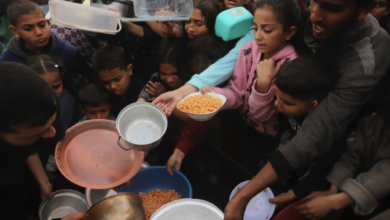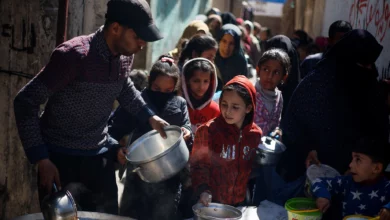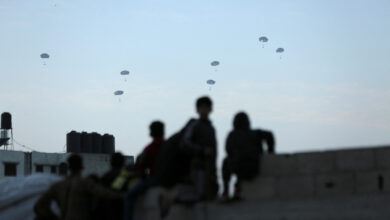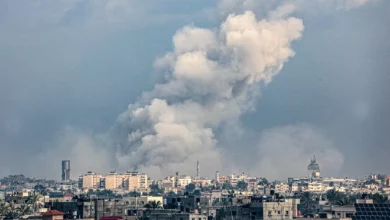DADAAB, Kenya – Omar Ali, a shepherd from southwest Somalia, sat with his five kids at the entrance of the UNHCR registration offices in Dadaab – perhaps the largest refugee camp in the world, located in Kenya, 90 km from the Somali border.
Ali had made the 22-day hike with his children through Somlia’s unforgiving terrain. Like thousands of others, he is waiting for the opportunity to officially register himself and be assigned a tent, space and food ration.
His story does not differ from many other refugees forced to escape the debilitating mixture of an insufferable climate and isolating disastrous civil strife. Last month, the UN officially declared a famine in southern Somalia, with millions of children suffering from acute malnutrition.
“Over the last couple of years, the drought killed the last of our livestock. My wife then died as we were unable to find her a doctor. I then realized I had to come here for my children’s safety and well-being,” he said.
Dadaab is more like a city, with around 440,000 Somali refugees according to a July estimate. Given the breadth of the UNHCR’s mission to run the camps, it is hardly accurate to say that Ali is being purposefully neglected. He wears a red tag on his arm, indicating that he has passed the transit phase of the camps and is now waiting on registration.
Transit stations accept the new daily batch of arrivals, which, according to UNHCR, reached more than a thousand daily in August.
“There’s never enough time, resources or space. At this center alone, we’ve been getting 200 new refugees every month,” said Mahd Abdy, who registers people in at UNHCR transit camp of Dagahley, one of the three camps in Dadaab, the other two being Ifo and Hagar Deir.
Families reach these camps with extremely malnourished children needing immediate and urgent medical and food aid, he said.
The transit stations, however, cannot hold refugees for more than one day and cannot ensure that everyone who comes in is immediately registered. They are forced to send those who cannot immediately gain an official status with the camps to a nearby long-term transitional site.
Here, the true plight of the refugees emerges. Until recently, the Dagahley refugees in these areas were left to their own devices.
Tiny dirt mounds – many not longer than 120 cm – jut out in between twig-lined tents. They're the feeble markings of many lives cut short due to the harsh conditions in these camps.
“I cannot say that the people here need anything specifically. They need everything,” said Imam Akbari, the project supervisor for the Indonesian crisis relief organization, ACT.
Aid organizations and philanthropists have found it difficult to navigate the camps, especially reaching the far ends, which keep getting further everyday.
The Dadaab camps have been housing Somali refugees since 1991, during a period of civil strife in Somalia. The residents closer to the center of Dadaab are mostly of the “old” refugees who have been there for 20 years.
Some aid groups such as CARE, Doctors Without Borders, and other local and international organizations emergency response operations responded in the wake of the new inflow of refugees.
The 40,000 people in the Dagahley transitional area alone, however, are still largely unregulated. As dire as their situation is, many refugees still prefer it to a return to Somalia, which faces what many describe as a truly medieval situation.
“The Shabab al-Mujahedeen forced us to pay alms to them, even during the drought when we had no money. At the same time, they don’t allow anyone who can come help us stay alive to come,” said 86 year-old Adnan Abdallah, who has not been physically able to resume his work as a farmer.
The interim government, according to Abdallah, is a bunch of children who cannot do anything.
A civil war broke out in Somalia in 1991 and no central government has run the country ever since. The militant Shabab al-Mujahedeen has split from the Islamic Courts Union after its defeat by the Transitional Federal Government in 2006, with the backing of Ethiopian and African Union troops. However, Shabab al-Majahedeen remains in control of large parts of the south, in a country where armed conflict lingers.
After two months in the transitional part of Dagahleya, Abdallah had one major issue.
“People who have been in the camps for years and do not need more food rations receive a lot of the charity, while we remain like this without any help,” he said.
The unorganized situation of the area – and the increased clutter with the new arrivals, who pour in daily – makes for a logistical nightmare for donors. Running an independent charity in Dagahley is not advisable.
“Anyone coming to distribute in this area has to do it through one of the organizations there," said aid worker Shaaban Mohamed.
To overcome the situation, many are listening to the advice existing organizations gave them while trying to understand how best to work in the labyrinth of the Dadaab camps.
“It is impossible to even speak of providing aid during the day. People who don’t receive tend to take it as an insult,” said Mohamed Adam, an aid worker at the Bukhari center in Dagahley.
However, the influx of donations to Dadaab is creating an explosive food distribution situation.
“From my shop alone, we package and distribute between four and five thousand aid bags to families everywhere,” said Hassan Deigh, a merchant in Dadaab.
Deigh benefits from the commercial wheel of crises where, as a food supplier in Dadaab, a spike in natural disasters or wars means that they get more business.
“Since the drought, business has picked up,” he said.
With the door of the Somalia crises open for the foreseeable future, Dadaab may be even more over-saturated, and this may cause the creation of other camps in other parts of the country.
Outside of Mandera, a Kenyan town on the Ethiopia-Kenya-Somalia borders, one such camp is forming, according to aid workers. Other refugees are happy to wait it out where they are in Dadaab.
“Many are staying at the dim hope that they will get the opportunity to win a visa lottery to the US,” said Abdallah.
Others fully acknowledge the reason behind their stay and are not intellectually resigned to waiting things out in the camps.
“I will just stay here until the crisis is over,” Abdallah added.




